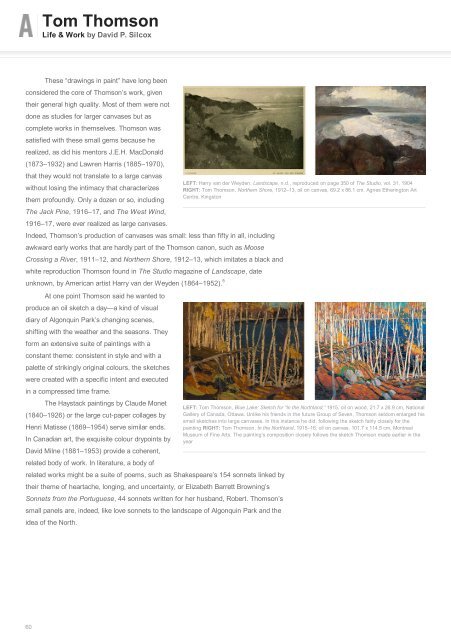Create successful ePaper yourself
Turn your PDF publications into a flip-book with our unique Google optimized e-Paper software.
<strong>Tom</strong> <strong>Thomson</strong><br />
Life & Work by David P. Silcox<br />
These “drawings in paint” have long been<br />
considered the core of <strong>Thomson</strong>’s work, given<br />
their general high quality. Most of them were not<br />
done as studies for larger canvases but as<br />
complete works in themselves. <strong>Thomson</strong> was<br />
satisfied with these small gems because he<br />
realized, as did his mentors J.E.H. MacDonald<br />
(1873–1932) and Lawren Harris (1885–1970),<br />
that they would not translate to a large canvas<br />
without losing the intimacy that characterizes<br />
them profoundly. Only a dozen or so, including<br />
The Jack Pine, 1916–17, and The West Wind,<br />
1916–17, were ever realized as large canvases.<br />
Indeed, <strong>Thomson</strong>’s production of canvases was small: less than fifty in all, including<br />
awkward early works that are hardly part of the <strong>Thomson</strong> canon, such as Moose<br />
Crossing a River, 1911–12, and Northern Shore, 1912–13, which imitates a black and<br />
white reproduction <strong>Thomson</strong> found in The Studio magazine of Landscape, date<br />
unknown, by American artist Harry van der Weyden (1864–1952).<br />
At one point <strong>Thomson</strong> said he wanted to<br />
produce an oil sketch a day—a kind of visual<br />
diary of Algonquin Park’s changing scenes,<br />
shifting with the weather and the seasons. They<br />
form an extensive suite of paintings with a<br />
constant theme: consistent in style and with a<br />
palette of strikingly original colours, the sketches<br />
were created with a specific intent and executed<br />
in a compressed time frame.<br />
The Haystack paintings by Claude Monet<br />
(1840–1926) or the large cut-paper collages by<br />
Henri Matisse (1869–1954) serve similar ends.<br />
In Canadian art, the exquisite colour drypoints by<br />
David Milne (1881–1953) provide a coherent,<br />
related body of work. In literature, a body of<br />
related works might be a suite of poems, such as Shakespeare’s 154 sonnets linked by<br />
their theme of heartache, longing, and uncertainty, or Elizabeth Barrett Browning’s<br />
Sonnets from the Portuguese, 44 sonnets written for her husband, Robert. <strong>Thomson</strong>’s<br />
small panels are, indeed, like love sonnets to the landscape of Algonquin Park and the<br />
idea of the North.<br />
LEFT: Harry van der Weyden, Landscape, n.d., reproduced on page 350 of The Studio, vol. 31, 1904<br />
RIGHT: <strong>Tom</strong> <strong>Thomson</strong>, Northern Shore, 1912–13, oil on canvas, 69.2 x 86.1 cm, Agnes Etherington Art<br />
Centre, Kingston<br />
5<br />
LEFT: <strong>Tom</strong> <strong>Thomson</strong>, Blue Lake: Sketch for “In the Northland,” 1915, oil on wood, 21.7 x 26.9 cm, National<br />
Gallery of Canada, Ottawa. Unlike his friends in the future Group of Seven, <strong>Thomson</strong> seldom enlarged his<br />
small sketches into large canvases. In this instance he did, following the sketch fairly closely for the<br />
painting RIGHT: <strong>Tom</strong> <strong>Thomson</strong>, In the Northland, 1915–16, oil on canvas, 101.7 x 114.5 cm, Montreal<br />
Museum of Fine Arts. The painting’s composition closely follows the sketch <strong>Thomson</strong> made earlier in the<br />
year<br />
60


